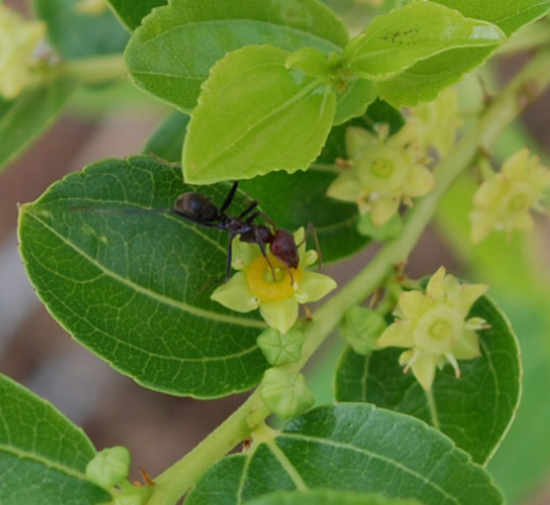 The Jujube Info and Care Reference Manual
The Jujube Info and Care Reference Manual- General Information
- The Jujube Tree
- Ziziphus jujuba Mill.
Ziziphus jujuba Mill.
Common names for the tree and fruit include Jujube, Chinese Jujube, Chinese Date, and Red Date. The Chinese for jujube is zăo 枣 (simplified) 棗 (traditional), and for jujube tree is zăoshù 枣树 (simplified) 棗樹 (traditional).
Botanically, jujube is classified in the Rhamnaceae (buckthorn) family and Ziziphus genus. The word ‘Ziziphus’ is from the Persian word zizfum or zizafun, the name of a deciduous shrub known botanically as Ziziphus lotus, which is native to the Mediterranean and closely related to the jujube.
A somewhat brief introduction to scientific naming, or binomial nomenclature: all species are named with two words, hence the ‘binomial’ part. These two words are always italicised (or underlined if handwritten or on a typewriter, as was typical up until the late 1980s). The first word denotes the genus and the second denotes the species. A genus is a group of species. There may be many species that share a genus name (Ziziphus being one example), but the species word is only ever assigned to one species within that genus. This is because a species is a unique organism, with characteristics that make it what it is, and nothing else. Thus the Ziziphus lotus above refers to a specific plant unambiguously identifiable by that name. If a botanist said or wrote Ziziphus lotus, every other botanist would know (or could look up) without confusion the exact plant referred to. Were a botanist to write or say Ziziphus sp., this means the plant referred to has enough about it to be unmistakably in the Ziziphus genus, but the exact species is unknown or doesn’t need to be described to such detail. Ziziphus spp. with two p’s is the plural form, ie referring to at least two different Ziziphus species. Species is a subset of genus, and genus is a subset of family. A species has unique characteristics and is the sole member of its group. A genus contains a group of species very similar to each other such that not much separates them, and a family contains a group of genera (plural form of ‘genus’) that in turn share similar characteristics. Only the genus and species names are italicised. Family (and higher) names are not.
Carl Linnaeus, the father of binomial nomenclature, first named the jujube as Rhamnus zizyphus in 1753. Philip Miller in 1768 however regarded it as unique enough to warrant its own genus, and named it Ziziphus jujube, using Linnaeus’ species name as the genus (note the differently spelled ‘Ziziphus’ and the ‘e’ on the end of ‘jujube’). This changed to Ziziphus zizyphus in 1882 (note the different spellings), and again in 2011 to Ziziphus jujuba (with an ‘a’ on the end). You may see this written as Ziziphus jujuba Mill. in publications. This is because botanists append an ‘author abbreviation’ when citing botanical names, to signify who first named (’authored’) the species. In this case of course, ‘Mill.’ stands for Philip Miller.
The Ziziphus genus consists of about 40 thorny shrubs and trees distributed around the world’s temperate and subtropical regions. Some are evergreen and some are deciduous.
The jujube tree, Ziziphus jujuba Mill., is deciduous. Botanically, the leaves are described as alternate (a single leaf at each node along the stem, ie leaves alternate either side of the stem). The leaves are ovate (egg-shaped, widest at the base) with an acute (pointed) tip. The leaf margin (edge) is serrulate (of very fine serration). Leaves are a bright glossy green with three prominent pale green veins fanning out from the base.
Flowers are very small, about 5 mm across, with five petals of a yellow-green colour. They are botanically known as perfect or hermaphroditic, having both male and female parts.
Botanically the fruit is called a drupe, a firm-textured fruit with a small stone inside. (Other examples of drupes include olives, coffee beans, mangoes and apricots.) The jujube stone contains two small seeds.
The fruit starts off green, but as it ripens red-brown splotches form across the surface until the entire fruit is a deep red colour.
On further ripening the fruit softens and wrinkles until it truly does resemble one of its names, the red date.
Fun fact: We call jujubes ‘red dates’, because, well that’s what they look like, ie red versions of the dried fruit of the date palm. The Chinese on the other hand refer to the fruit of the date palm as ‘palm jujube’, zōnglú zǎo 棕榈枣 (simplified) 棕櫚棗 (traditional) as palm dates look like their jujubes!
About the Author
BSc(Hons), U.Syd. - double major in biochemistry and microbiology, with honours in microbiology
PhD, U.Syd - soil microbiology
Stumbled into IT and publishing of all things.
Discovered jujube trees and realised that perhaps I should have been an agronomist...
So I combined all the above passions and interests into this website and its blog and manuals, on which I write about botany, soil chemistry, soil microbiology and biochemistry - and yes, jujubes too!
Please help me buy a plant if you found this article interesting or useful!




